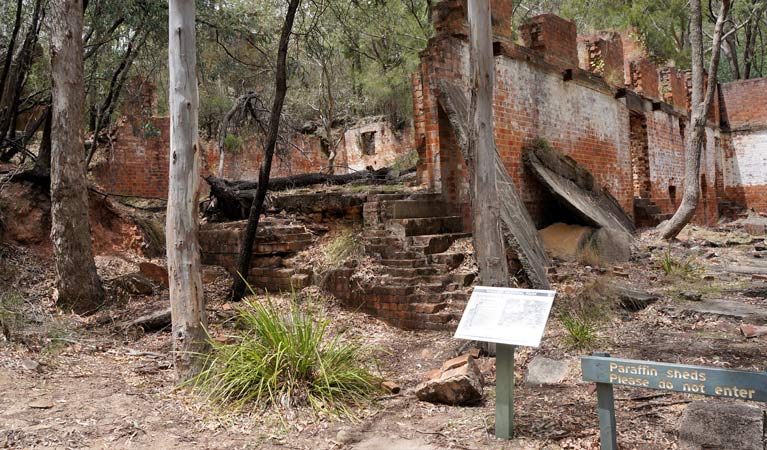Newnes Industrial Ruins walk
Wollemi National Park
Overview
Take a walk through historic Newnes Industrial Ruins in Wollemi National Park, near Lithgow. You won’t forget the eerie experience of walking among ruins that are gradually being reclaimed by nature.
- Accessibility
- No wheelchair access
- Distance
- 2.5km
- Time suggested
- 1hr 30min - 2hrs 30min
- Grade
- Grade 3
- What to
bring - Drinking water, sunscreen, hat
- Please note
- The Ruins carpark is only accessible by 4WD or rock hopping on foot across the Wolgan River. Please don’t try crossing the river in a 2WD.
- If crossing the river on foot, you'll need to add an extra 1km (approx. 20-30mins) each way to the Ruins carpark.
- Please don’t climb the fragile ruins as they can be unstable
- Remember to stay on the track as there are hidden holes off the track
Located at the head of the Wolgan Valley, enjoy this fascinating walk into the history of Newnes – once the site of a thriving shale oil mining industry. You’ll see some remarkably well-preserved remnants of the area’s mining history, including old coke ovens, brick kilns, paraffin sheds and crumbling walls.
Starting at the Ruins carpark, the walking track zig zags across the large site, which is on a steep slope. The 15m ‘Big Wall’ is a highlight, and the unique beehive kilns are the largest of their type in Australia. Keep an eye out for wedge-tailed eagles soaring above, wombats, and wallabies.
Follow the route of the railway line back to the carpark. If walking from the river crossing, you'll need to add an extra 1km each way.
Map
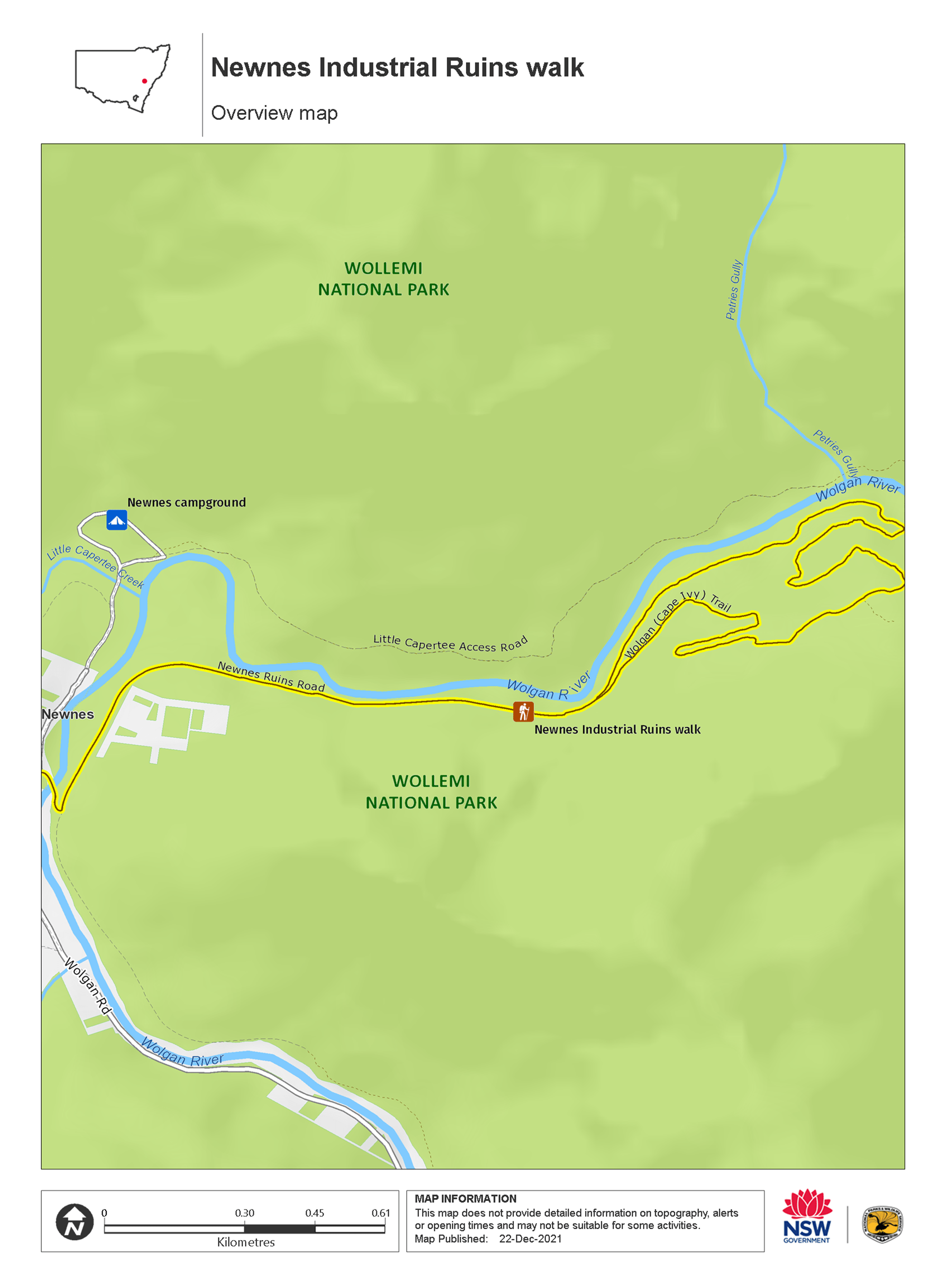
Map
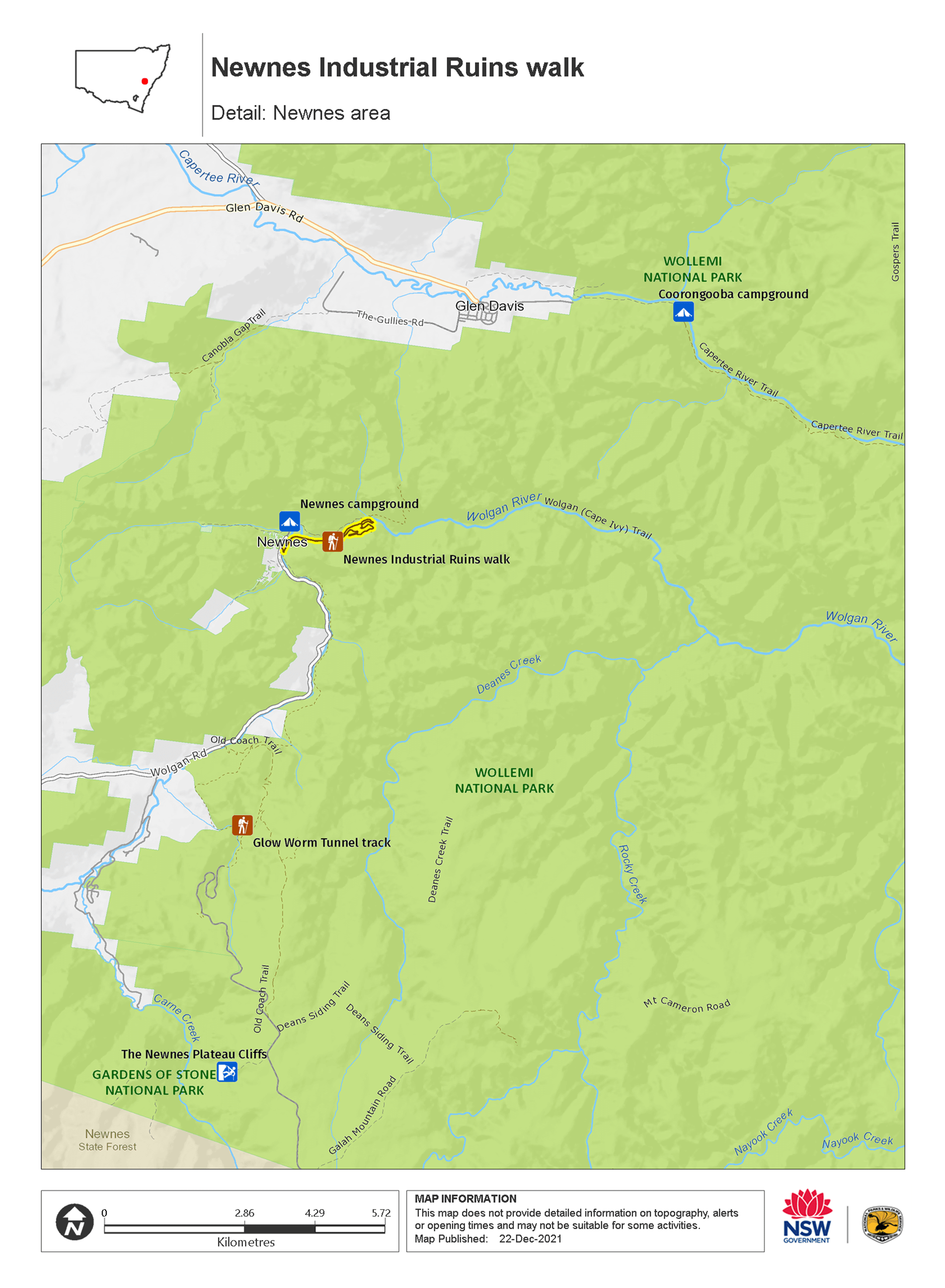
Map legend

Local alerts
For the latest updates on fires, closures and other alerts in this area, see https://www.nationalparks.nsw.gov.au/things-to-do/walking-tracks/newnes-industrial-ruins-walk/local-alerts
General enquiries
- National Parks Contact Centre
- 7am to 7pm daily
- 1300 072 757 (13000 PARKS) for the cost of a local call within Australia excluding mobiles
- parks.info@environment.nsw.gov.au
Park info
- in Wollemi National Park in the Sydney and surrounds, North Coast and Country NSW regions
Wollemi National Park is always open but may have to close at times due to poor weather or fire danger.
Visitor info
All the practical information you need to know about Newnes Industrial Ruins walk.
Track grading
Features of this track
Distance
2.5km
Time
1hr 30min - 2hrs 30min
Quality of markings
Clearly sign posted
Experience required
No experience required
Gradient
Short steep hills: The walk has short steep hills and the ruins site is on a steep slope.
Quality of path
Formed track: The walk is hard-packed ground along its length.
After crossing the Wolgan River It follows a 4m-wide dirt 4WD road up to the ruins carpark. From there the walk narrows to a 1m-wide track.
Steps
Occasional steps: Towards the end of the track there are multiple sets of steps, ranging from between 5 to 60 steps each.
Other barriers
Gates: There's an emergency pipe swing gate at the start of the walk that's locked seasonally. There's enough space for walkers to get around this gate, but there's not enough space for wheelchairs or prams.
Other barriers: At the start of the walk, the track crosses Wolgan River. You'll need to rock hop across the water to get to the other side.
Getting there and parking
Newnes Industrial Ruins are in the Lithgow area of Wollemi National Park.
To get there from Lithgow:
- Follow the Great Western Highway west from Lithgow for 6.5km, then take the Castlereagh Highway exit towards Mudgee.
- At the village of Lidsdale, turn right onto Wolgan Road towards Wollemi National Park and Newnes.
- Newnes is around 34km from the Lidsdale turnoff.
- Cross the Wolgan River at the 4WD ford 100m north of the old Newnes Hotel, and turn left onto the gravel road.
- You’ll pass several camping sites on your left before reaching the Ruins carpark. The signposted track begins at the locked gate.
If walking to the ruins site:
- Cross the Wolgan River using the stepping stones, and follow the gravel road on the left around 1km to Newnes Ruins carpark, where the track begins.
Road quality
- Mixture of sealed and unsealed roads
Vehicle access
- All roads require 4WD vehicle
Weather restrictions
- 4WD required in wet weather
Parking
Parking is available at the hard-packed ground ruins carpark or near the Wolgan River crossing and Newnes Hotel.
Maps and downloads
Accessibility
Disability access level - no wheelchair access
Newnes Industrial Ruins walking track is not suitable for wheelchairs or prams and may be challenging for people with reduced mobility:
- There's a river crossing at the start of the walk where you need to rock hop to get to the other side
- There's a pipe swing gate at the start of the walk that's locked seasonally. There's enough space for walkers to get around this gate, but there's not enough space for wheelchairs or prams.
- There are many steps towards the end of the walk in sets off between 5 to 60 steps each
- The walk has short steep hills and the ruins site is on a steep slope.
Although there are no bench seats along this track, you'll find picnic tables at Newnes Cricket Pitch near the start of the walk for resting.
Prohibited
Pets
Pets and domestic animals (other than certified assistance animals) are not permitted. Find out which regional parks allow dog walking and see the pets in parks policy for more information.
Smoking
NSW national parks are no smoking areas.
Learn more
Newnes Industrial Ruins walk is in Wollemi National Park. Here are just some of the reasons why this park is special:
Ancient connections
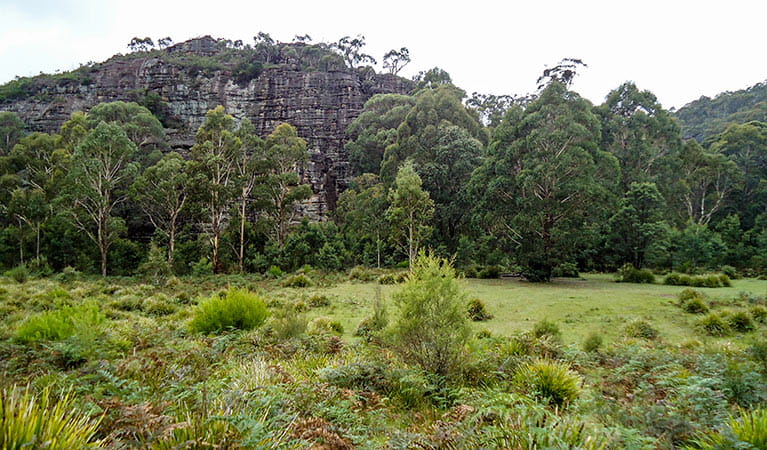
The area that is now Wollemi National Park has held significance to Aboriginal people for at least 12,000 years. Evidence of this connection can be seen throughout the park, including ceremonial grounds, stone arrangements, grinding grooves, scarred trees and rock engravings. There are around 120 known Aboriginal sites in the park and probably many more yet to be discovered. The Wiradjuri, Dharug, Wanaruah and Darkinjung people have a strong and ongoing cultural association with their traditional lands and waters.
- Guided kayak tours of Ganguddy-Dunns Swamp Experience the natural beauty of escarpments, gorges and wildlife on a guided paddling tour of Gunguddy-Dunns Swamp with Southern Cross Kayaking.
- Pagoda Lookout walking track Pagoda Lookout walking track is a short but steep walk near Rylstone in Wollemi National Park. Enjoy incredible views over ancient pagoda rock formations and the Cudgegong River.
Geological marvels
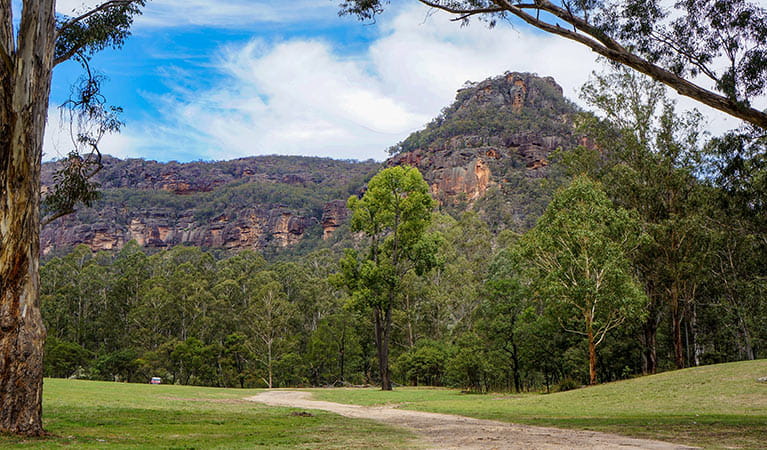
Wollemi's landscape has been sculpted over millennia into a magnificent network of soaring sandstone escarpments, plunging gorges and canyons, winding river valleys and awe-inspiring geological and geomorphological features such as pagoda rock formations, basalt-capped mountains and diatremes. The spectacular Colo gorge and its tributaries form the most extensive sandstone canyon system in eastern Australia. Grab your camera and discover for yourself the breathtaking vistas and natural marvels that make this a World Heritage treasure.
- Explore Wollemi's wonders guided tour Experience the highlights of Wollemi National Park on this guided tour with Hikeandseek NSW. Traverse canyons, tunnels and valleys while learning about the area’s history.
- Guided kayak tours of Ganguddy-Dunns Swamp Experience the natural beauty of escarpments, gorges and wildlife on a guided paddling tour of Gunguddy-Dunns Swamp with Southern Cross Kayaking.
- Pagoda Lookout walking track Pagoda Lookout walking track is a short but steep walk near Rylstone in Wollemi National Park. Enjoy incredible views over ancient pagoda rock formations and the Cudgegong River.
- Wollemi camping and canyoning expeditions Join Roam Adventures and Training on a camping and canyoning adventure in the stunning Wollemi National Park.
Nature's haven
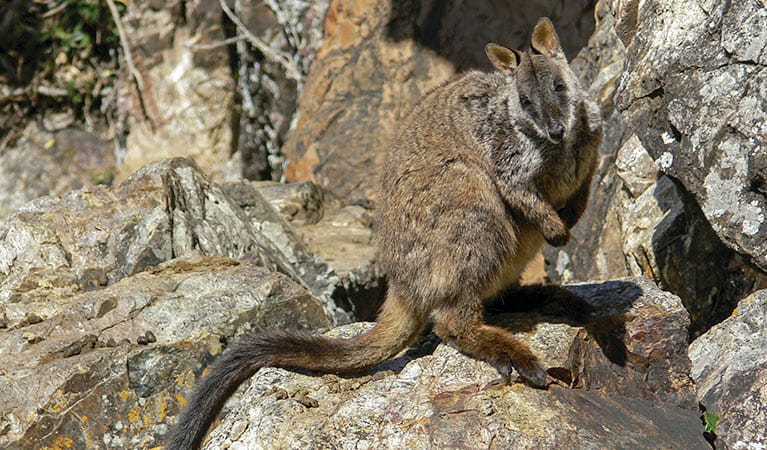
It's little surprise that Wollemi's spectacular landscape shelters a rich diversity of plants and animals. The rare Wollemi pine - a 'living fossil' whose closest relatives thrived some 90 million years ago was rediscovered here in 1994, and the park protects an incredible array of botanical species and communities, from open eucalypt forest and woodlands including Hawkesbury and grey box, to rainforests and perched swamps. This variety makes it an appealing habitat for eastern grey kangaroos, red-necked wallabies and the elusive brush-tailed rock wallaby, as well as the beautifully marked broad-headed snake, regent honeyeater and glossy black cockatoo. Around 55 species of butterfly have also been recorded.
- Wollemi guided Glow Worm Tunnel walk Join Wolgan Valley Eco Tours on the popular Glow Worm Tunnel walking track in Wollemi National Park and see the magical natural light show created by thousands of glow worms.
Outdoor adventure
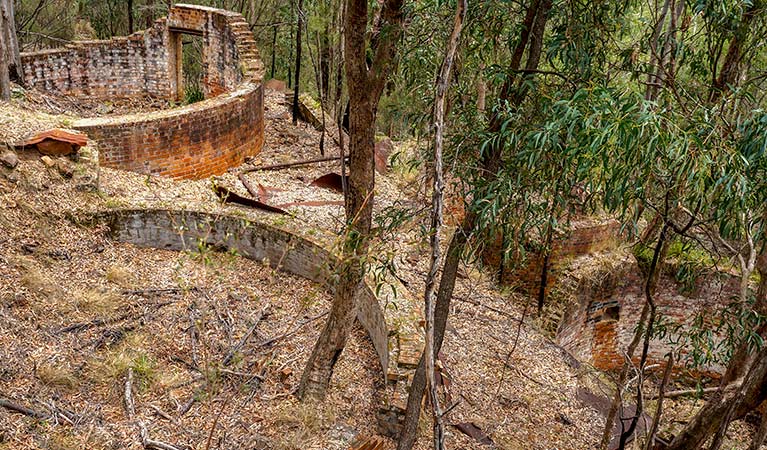
Pitch a tent at one of Wollemi's great campgrounds, like the secluded Colo Meroo backpack campground, the car-accessible Coorongooba campground or the dramatically-situated, car-accessible Newnes campground. With your base set up, you're free to get out and enjoy the park's fantastic outdoor attractions, be they more relaxed pursuits such as picnicking, canoeing and swimming or something more adventurous like rock climbing, horseriding and hiking.
Plants and animals protected in this park
Animals
-

Superb lyrebird (Menura novaehollandiae)
With a complex mimicking call and an elaborate courtship dance to match, the superb lyrebird is one of the most spectacular Australian animals. A bird watching must-see, the superb lyrebird can be found in rainforests and wet woodlands across eastern NSW and Victoria.
-

Bare-nosed wombat (Vombatus ursinus)
A large, squat marsupial, the Australian bare-nosed wombat is a burrowing mammal found in coastal forests and mountain ranges across NSW and Victoria. The only other remaining species of wombat in NSW, the endangered southern hairy-nosed wombat, was considered extinct until relatively recently.
-

Southern boobook (Ninox novaeseelandiae)
The southern boobook, also known as the mopoke, is the smallest and most common native owl in Australia. With a musical 'boo-book' call that echoes through forests and woodlands, the southern boobook is a great one to look out for while bird watching.
-
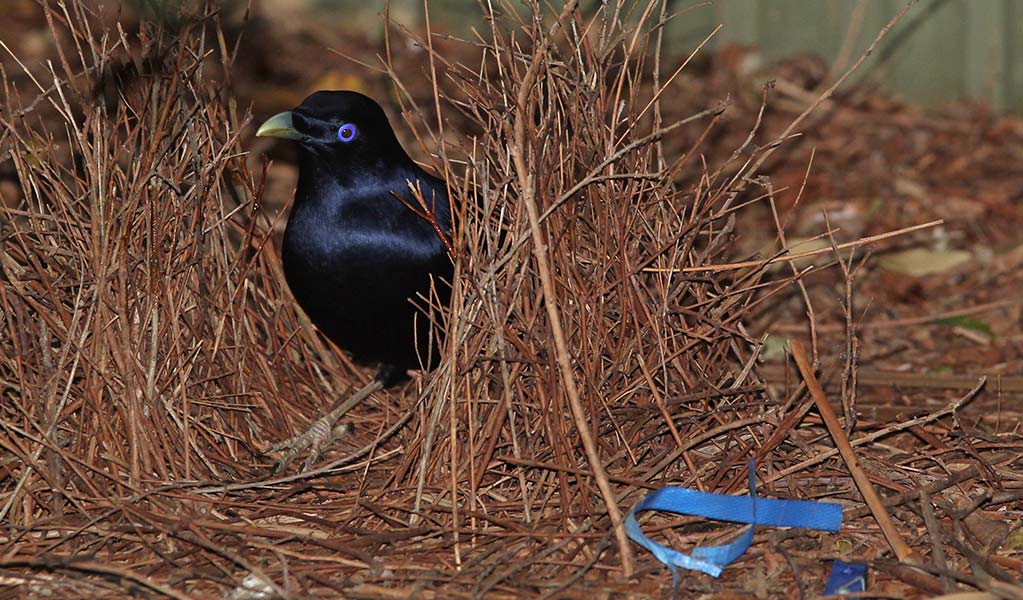
Satin bowerbird (Ptilonorhynchus violaceus)
With vibrant blue-violet eyes and curious antics, the satin bowerbird is a favourite for bird watching and easy to spot as it forages for food in open forest. Relatively common across eastern Australia, in NSW they’re found in coastal rainforests and adjacent woodlands and mountain ranges.
-
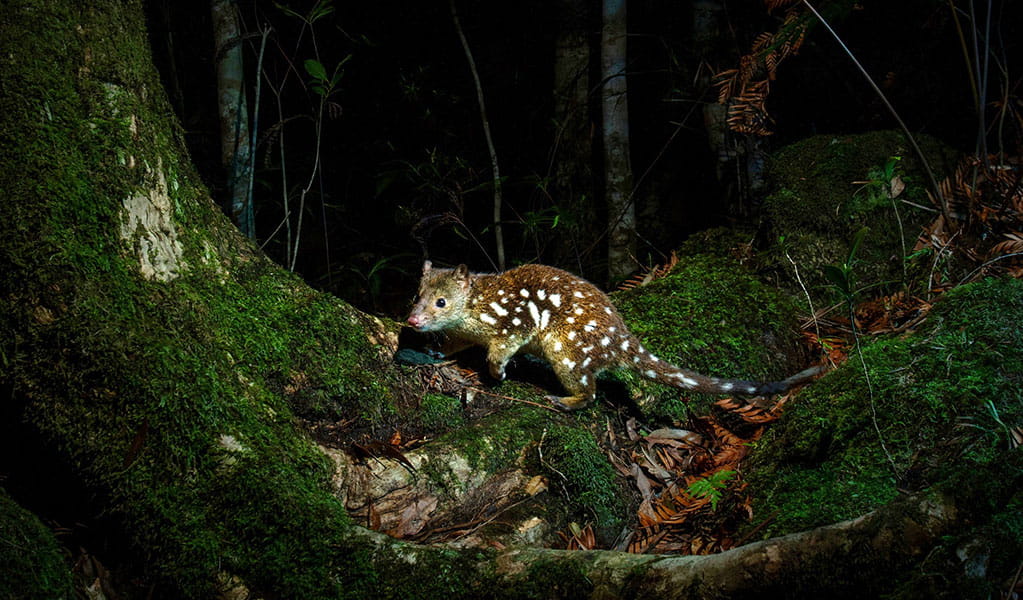
Spotted-tailed quoll (Dasyurus maculatus)
The spotted-tailed quoll is the largest remaining carnivorous marsupial on the Australian mainland. It’s protected as a vulnerable species in NSW.
Plants
-
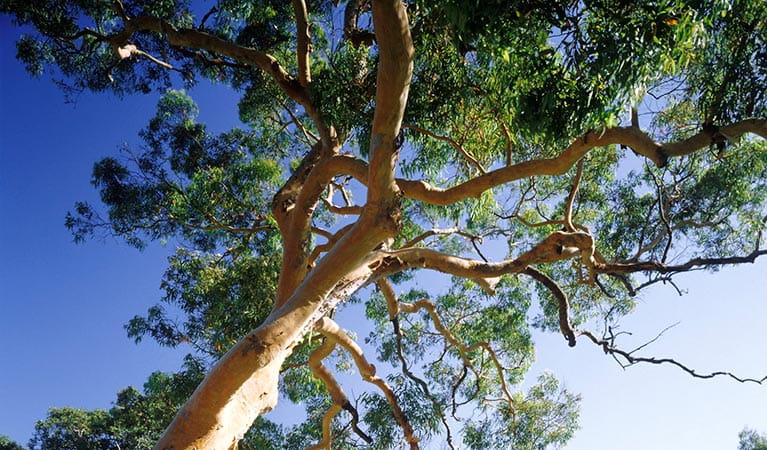
Smooth-barked apple (Angophora costata)
Smooth-barked apple gums, also known as Sydney red gum or rusty gum trees, are Australian native plants found along the NSW coast, and in the Sydney basin and parts of Queensland. Growing to heights of 15-30m, the russet-coloured angophoras shed their bark in spring to reveal spectacular new salmon-coloured bark.
-
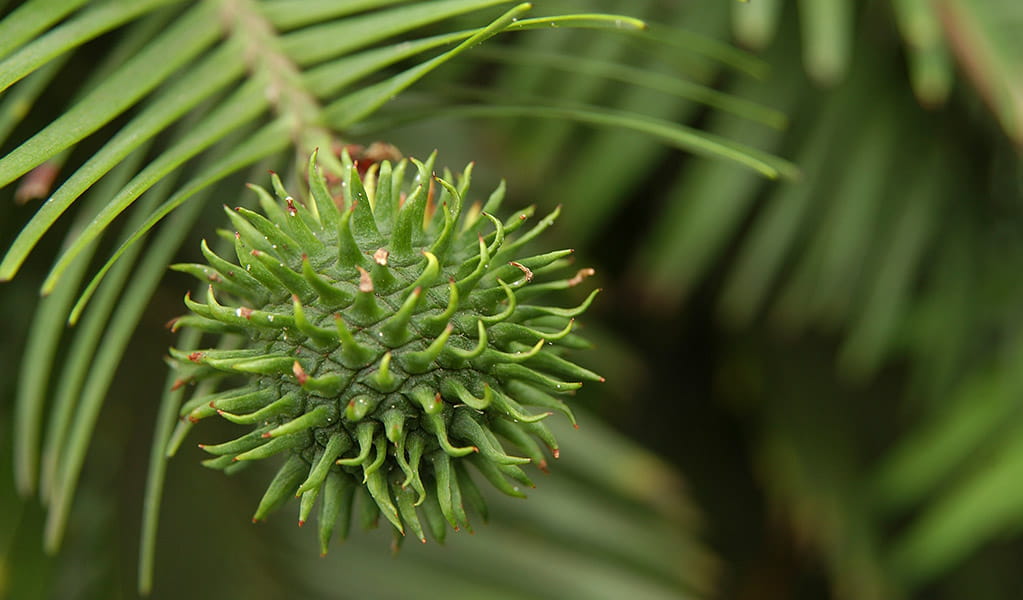
Wollemi pine (Wollemia nobilis)
The Wollemi pine is one of the world’s oldest and rarest trees. Only 46 adult trees and 43 juveniles remain in the wild. Belonging to a 200 million year-old plant family, this critically endangered Australian species is considered a global treasure.

